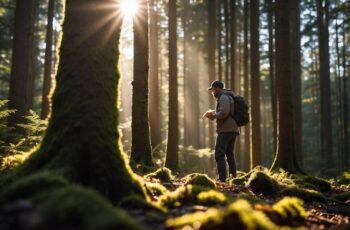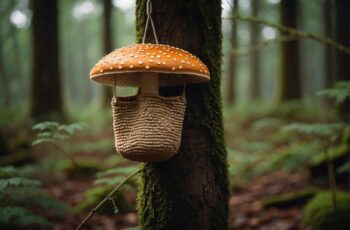Mushroom foraging is a popular outdoor activity that allows you to explore nature while searching for edible fungi. Equipping yourself with the right tools is essential to have a successful and safe mushroom hunting experience. This article will provide you with information about the must-have mushroom foraging tools to make your next foray into the woods productive and enjoyable.
One key tool for mushroom hunting is a foraging knife, which helps you gently cut mushrooms from their stems and carry them without bruising the delicate flesh. Another important tool is a mushroom bag, designed to allow spores to disperse and promote future growth as you collect your bountiful harvest. Finally, having a reliable mushroom guide will help you identify edible mushrooms and avoid potentially toxic ones, ensuring your safety and enriching your knowledge in the process.
With the proper mushroom foraging tools in hand, you are well-prepared for an enjoyable and successful foraging adventure. Remember to keep safety in mind, respect nature, and have fun exploring the fascinating world of fungi.
Essential Mushroom Foraging Tools
Mushroom foraging is a delightful hobby that lets you explore the wilderness and discover the various fungal inhabitants in your region. To help you harvest efficiently and safely, here are some essential tools you’ll need on your foraging adventures.
Mushroom Knife
A mushroom knife is essential for safely cutting and harvesting mushrooms. You should look for a knife with a curved blade as well as a foldable design. The Opinel No.08 Carbon Steel Folding Pocket Knife is a popular choice among foragers. A quality mushroom knife should have these features:
- Curved and sharp blade
- Folding design for portability and safety
- Built-in brush for cleaning your finds
Basket or Mesh Bag
When foraging for mushrooms, you’ll need something to carry your finds in. A basket or mesh bag helps prevent your mushrooms from getting crushed, and allows air circulation to keep them fresh. You can choose between a traditional wicker basket or a convenient mesh bag. Whichever you prefer, ensure it’s spacious enough for your typical harvest.
Field Guide
When foraging, it’s crucial to identify the mushrooms you find accurately. A mushroom field guide is an invaluable tool to help you learn about and identify various species in your area. Look for a guide that covers your specific region, such as the Mushrooms of the Pacific Northwest guide. Ensure the guide has quality photos and descriptions, so you can confidently identify your findings. In addition:
- Note the guide’s emphasis on poisonous mushrooms and edible ones
- Make sure the guide is portable, so it’s easy to carry while foraging
- Check for additional features, like tips on foraging techniques and recipes
Remember, with the right tools and knowledge, your mushroom foraging adventures can be both fun and rewarding. Stay safe and enjoy exploring nature’s fungal treasures!
Additional Useful Tools
GPS or Smartphone App
When foraging for mushrooms, it’s important to keep track of your location in the wilderness. Having a GPS or a smartphone app such as Google Maps can help you navigate and mark spots where you found mushrooms. This is valuable information for future foraging trips, allowing you to focus on areas with higher chances of success.
Magnifying Glass
While a knife, bag or basket, and a field guide are common mushroom foraging essentials, a magnifying glass is often overlooked. This small tool can be especially helpful in examining the finer details of a mushroom, such as gill structure or spore color. These observations can greatly aid in identifying various mushroom species and avoiding toxic ones. Keep a magnifying glass in your pocket, and use it to inspect your finds before adding them to your collection.
Notebook and Pen
In addition to your GPS or smartphone app, carrying a weather-resistant notebook and pen is essential. You can use this to jot down information about mushrooms, draw sketches, or describe where you found them. Gathering this information can help you become a more knowledgeable forager and significantly improve your ability to identify species. Choose a pen with waterproof ink, as it won’t run if the paper gets wet. Remember to review your notes regularly to reinforce your understanding of mushrooms and their habitat.
Safety Considerations
When it comes to mushroom foraging, safety is of utmost importance. There are several aspects to consider to ensure a safe and successful foraging experience. In this section, we will discuss three crucial areas: proper identification, knowing your terrain, and minding the weather.
Proper Identification
One of the most crucial steps in mushroom foraging is identifying the mushrooms you find correctly. Some species are poisonous and can cause severe health issues if consumed. To make sure you are safe while foraging, follow these guidelines:
- Always consult a reputable mushroom field guide or use a recognized smartphone app for identification.
- If you’re a beginner, start by learning the most common edible mushrooms and their toxic look-alike species.
- Never consume a mushroom unless you are 100% sure of its identification. If in doubt, leave it out.
Knowing Your Terrain
Familiarizing yourself with the area where you plan to forage is essential for several reasons:
- Understanding the habitat and growth patterns of different mushroom species can help in locating and identifying them.
- Familiarity with the terrain can help you avoid dangerous areas, such as unstable ground or areas prone to flooding.
- Being aware of the presence of wildlife or plants, such as poison ivy, can prevent accidents or injuries.
Before you go foraging, research the area by consulting maps, reading about the location’s specific features, or talking to other experienced foragers.
Minding the Weather
Weather conditions can significantly impact mushroom growth and the overall foraging experience. Keep the following points in mind when planning your foraging trip:
- Monitor the local weather forecast to avoid going out in extreme temperatures or during storms.
- After heavy rainfall, mushrooms tend to flourish, so you may encounter a more diverse range of species. However, be cautious, as moist conditions can also make it more challenging to identify certain mushroom types.
- Dress appropriately for the forecasted weather and pack any necessary gear, such as waterproof clothing or sun protection.
By focusing on these safety considerations, you will be better equipped to have a successful and secure mushroom foraging experience.
Caring for the Environment
Sustainable Foraging Practices
When foraging for mushrooms, it’s crucial to practice sustainability. Always positively identify the mushrooms before harvesting, as this not only ensures your safety but also helps maintain the ecosystem. Make use of a mushroom pocket guide for accurate identification.
Moreover, avoid overharvesting by taking only what you need. When picking mushrooms, consider cutting them at the base, rather than uprooting them, as this can damage the mycelium and impair future growth. Finally, be respectful of the habitat and other organisms residing within it.
Leave No Trace Principles
Incorporating the Leave No Trace principles into your mushroom foraging practices is essential for minimizing your impact on the environment. Here are some tips to adhere to these principles:
- Plan ahead and prepare: Before setting off on your mushroom-foraging adventure, familiarize yourself with the area, regulations, and potential hazards. Bring the appropriate gear, such as a foraging bag, knife, and brush. Be prepared for changes in the weather conditions and know what type of terrain you will encounter.
- Travel and camp on durable surfaces: Stay on established trails and avoid trampling on vegetation. Set up your campsite at least 200 feet away from lakes and streams to protect water sources.
- Dispose of waste properly: Carry a trash bag with you to pack out all your waste, including food scraps and litter. Never dump anything in water sources.
- Leave what you find: Preserve the natural environment by not picking plants, breaking tree branches, or moving rocks. You should also avoid introducing any non-native species.
- Minimize campfire impact: Use a camp stove for cooking instead of making a campfire. If fires are allowed, use established fire rings and keep the fire small.
- Respect wildlife: Observe animals from a distance and avoid feeding them, as this can alter their natural behaviors. Store your food and trash securely to prevent wildlife from accessing it.
- Be considerate of other visitors: Maintain a low profile by keeping noise levels down, respecting others’ privacy, and always yield to other hikers on the trail. Share the wonders of nature with those around you by following these guidelines, and together you can help preserve the environment for future generations of foragers and outdoor enthusiasts.


